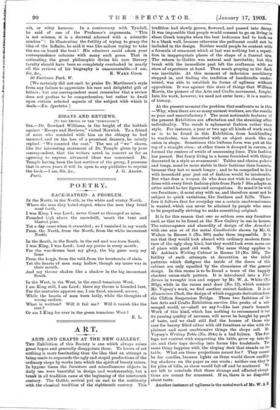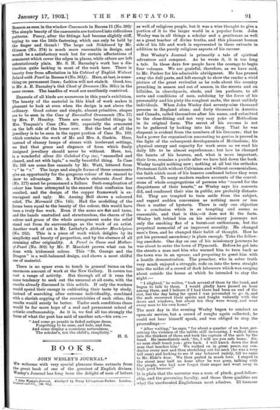ART.
ARTS AND CRAFTS AT THE NEW GALLERY. Tim Exhibition of this Society is one which always raises great hopes and generally disappoints them. To lovers of art nothing is more fascinating than the idea that an attempt is being made to supersede the ugly and stupid productions of the ordinary shops by works into which the spirit of beauty enters. In bygone times the furniture and miscellaneous objects in daily use were beautiful in design and workmanship, but a break ill all tradition came at the beginning of the nineteenth century. The Gothic revival put an end to the continuity with the classical tradition of the. eighteenth century. This
tradition had slowly grown, flowered, and passed into decay. It was impossible that people would consent to go on living in sham Greek temples when the best bedrooms had to look-on to a blank wall, because otherwise the pediment could not be included in the design. Neither would people be content with a formula of ornament which at last was nothing but a repeti- tion in inappropriate places of the shape of a funeral urn. The return to Gothic was natural and inevitable; but this break with the immediate past left the craftsman with no store of experience at hand. Thus much groping in the dark was inevitable. At this moment of indecision machine/7 stepped in, and finding the tradition of handicrafts under- mined, was able to establish its forms of ugliness without opposition. It was against this state of things that William Morris, the pioneer of the Arts and Crafts movement, fought. Into his work, however, we need not enter here ; it is a matter of history.
At the present moment the problem that confronts us is this —Why, when there are so many earnest workers, are the results so poor and unsatisfactory ? The most noticeable features of the present Exhibition are affectation and the straining after individuality. The result is ephemeral fashion rather than style. For instance, a year or two ago all kinds of work such as is to be found in this Exhibition, from bookbinding to wardrobes, was decorated with an object much like an onion in shape. Sometimes this bulbous form was put at the top of a straight stem ; at other times it drooped in curves, or formed the centres of swirls of unmeaning lines. This fashion has passed. But fancy living in a house furnished with things decorated in a style so evanescent! Tables and chairs, pokers and tongs, must be more stable in their fashions than bonnets, because they last so much longer ; and to be compelled to live with household gear just out of fashion would be intolerable. But what does a woman do who does not wish to change her dress with every fresh fashion-plate from Paris ? She adopts an attire suited to her figure and occupations. So must it be with our furniture ; it must stay with us, and therefore must not be subject to quick variations, like feathers and frills. There- fore it follows that for everyday use a certain unobtrusiveness is wanted, which can never be attained by people who seem to be perpetually striving to make something original.
It is for this reason that one so seldom sees any furniture such as that to be found at the New Gallery in use in houses, The extravagance and absurdity of design of the Armchair with one arm or of the metal Candlesticks shown by Mr. G. Walton in Recess 5 (No. 360) make them impossible. It is not that they would look absurd with ordinary modern furni- ture of the ugly shop kind, but they would look even more out of place with good old work. The same thing applies to Mr. Ashbee's Writing Cabinet in Recess 13 (No. 395). The futility of such attempts at decoration as the inlaid patterns which disfigure the inside of the doors of this cabinet are only equalled by the clumsiness of the general design. In this recess is to be found a trace of the happily
obsolete onion-stalk pattern. It is introduced into a Fire- Screen in wrought iron and copper by Mr. W. A. W hite (No.
395g), while in the recess next door (No. 12), which contains Mr. Voysey's work, we find another extinct fashion. It is an Aluminium Clock, the design of which suggests derivation from the Clifton Suspension Bridge. These two fashions of the last Arts and Crafts Exhibition survive like peaks of a sub- merged world, or—phall we say ?—like last year's bonnets. Work of this kind, which has nothing to recommend it but its passing quality of newness, will never be bought by people of taste, and we shall still find the houses of those who care for beauty filled either with old furniture or else with the plainest and most unobtrusive things the shops sell. Mr. Voysey's Writing Table (No. 394z) is a bad failure. The four legs, not content with supporting the table, grow up into the air, and their tops develop into forms like toadstools. The same thing happens with the sloping desk that stands on the table. What are these projections meant for ? They cannot be for candles, because lights on them would throw conflict- ing shadows on the paper as one wrote ; neither can they he for piles of bills, as these would fall off and be scattered. We are left to conclude that these strange and affected elonga- tions are meant for ornament. If so, there is no disputig about taste.
Ariether instance of ugliness is the metalwork of Mr. W. A. g Benson as seen in the window Casements in Recess 11 (No. 393)* The simple beauty of the casements are tortured into ridiculous patterns. Fancy, after the fittings had become slightly stiff, trying to use the little fastening, which can only be held by the finger and thumb ! The large oak Sideboard by Mr. Gimson (No. 374) is much more reasonable in design, and would be a satisfactory work but for certain affectations of ornament which cover the edges in places, while others are left ostentatiously plain. Mr. S. H. Barnsley's work has a dis- tinction quite lacking in most of the work here. There is beauty free from affectation in his Cabinet of English Walnut Inlaid with Pearl in Recess 6 (No. 361f). Here, at last, is some- thing on permanent lines; fashion will not stale it. Good, too, is Mr. A. E. Barnsley's Oak Chest of Drawers (No. 361e) in the same recess. The handles of wood are excellently contrived.
Enamels of all kinds are numerous in this year's exhibition.
The beauty of the material in this kind of work makes it pleasant to look at even when the design is not above the ordinary. Good colour and simple, almost primitive, shapes are to be seen in the Case of Enamelled Ornaments (No. 57) by Mrs. P. Hensley. There are some beautiful things in Mrs. Traquair's Case (No. 330), especially the ornament on the left side of the lower row. But the best of all the jewellery is to be seen in the upper portion of Case No. 169, which contains the work of Mr. and Mrs. A. Graskin. Here, instead of clumsy lumps of stones with irrelevant settings, we find that grace and elegance of form which finely designed jewellery should never be without. Here, too, is a wonderful silver Sir Galahad Cup (ss)," enamelled and chased, and set with lapis," a really beautiful thing. In Case
No. 168 are some fine enamels by Mr. Watt, lettered from "a" to "a." The large and simple forms of these ornaments
give an opportunity for the gorgeous colour of the enamel to show to advantage. Mr. A. Fisher's elaborate Jewel Box (No. 177) must be pronounced a failure. Such complication of colour has been attempted in the enamel that confusion has resulted, and the design of the copper framework is ex- travagant and ugly. Mr Aiming Bell shows a coloured relief, The Mermaid (No. 145). Had the modelling of the forms been equal to the beauty of the colour, this would have been a truly fine work. Even if the arms are flat and tame, and the hands unstudied and structureless, the charm of the colour and grace of the whole arrangement make the relief stand out from its surroundings as the work of an artist. Another work of art is Mr. Lethaby's Alabaster Mantelpiece (No. 252). This is a piece of work which delights by its simplicity and beauty of proportion, and by the absence of all straining after originality. A Panel in Gesso and Mother- if-Pearl (No. 302) by Mr. F. Marriott proves what can be done with iridescent colour. This "St. George and the Dragon" is a well-balanced design, and shows a most skilful use of material.
There is no space even to touch in general termson the enormous amount of work at the New Gallery. It covers too vast a range of activity. But through all of it runs the same tendency to seek out the unusual at all costs, with the results already discussed in this article. If only the workers. would spend their energy in cultivating their taste by study, instead of searching after extreme individuality, combined
with a slavish copying of the eccentricities of each other, the results would surely be better. Under such conditions there would be far more hope of a real and permanent school of artistic craftsmanship. As it is, we feel all too strongly the force of what the poet has said of another art—his own :—
"And some go prankt in faded antique dress, Forgetting to be sane, and hale, and free, And some display a conscious naturalness, The scholar's, not the child's, simplicity."
H. S.











































 Previous page
Previous page